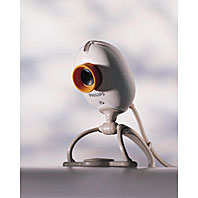
There has been a lot of interest in the use of cheap webcams for astronomical imaging by amateurs. With the right webcam and software it is possible to take high quality images of the moon and the planets which are difficult to match with even expensive CCD cameras. This works by effectively taking hundreds of images either as an AVI movie file or just a collection of BMP bitmaps. These may be collected over a period of several minutes and during this period there will be times when images are sharp and others when they are blurred due to atmospheric distortion etc. The software allows you to automatically discard the blurred images and sum the good ones, then further process that to get the sharpest image.
The first step to this type of imaging is to acquire a webcam, but this must be one with a CCD sensor and NOT a CMOS one - CCDs are much more sensitive and work much better in low light conditions. There are a little more expensive but are worth the money. Typical models include the Philips TouCam Pro (make sure you get the 740 or 750 model, not the 720/730 which are CMOS based) and the Philips Vesta Pro.
 |
Philips TouCam Pro PCVC740K |
Next the lens must be unscrewed and an adaptor used to fit the camera in the scope. This is effectievly an adaptor that screws into the camera and converts it to a 1.25" slot-in eyepiece. These have been called Mogg adaptors, after Steve Mogg - a pioneer in this field. Try your local astronomy store for one or BCF can supply them.
The software to drive the camera and then process the images is fortunately available free over the internet. I have used Astrosnap and Registax for this. Click on the links to download the software. Further information can be obtained on the QuickCam and Unconventional Imaging Astronomy Group or QCUIAG.
Here are some of my images:-